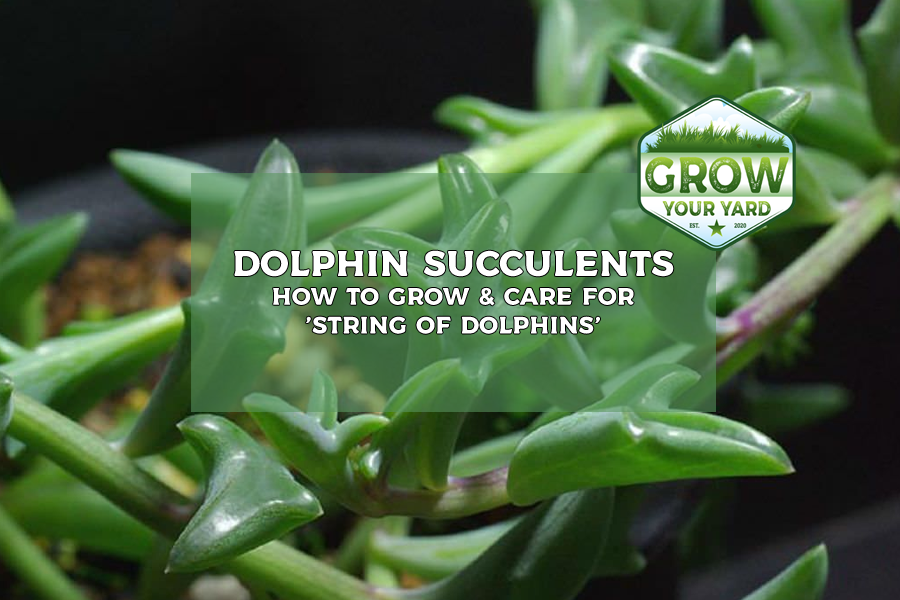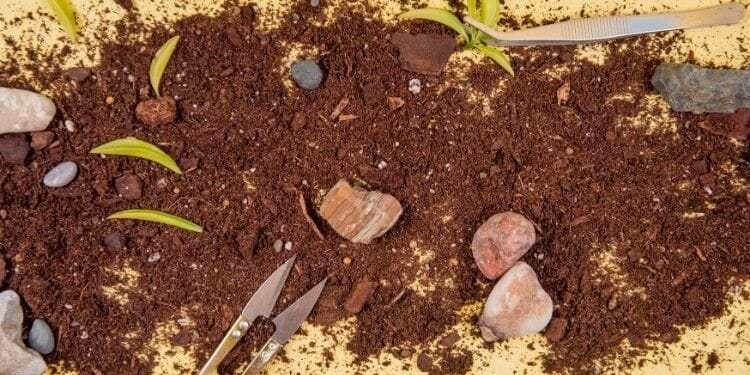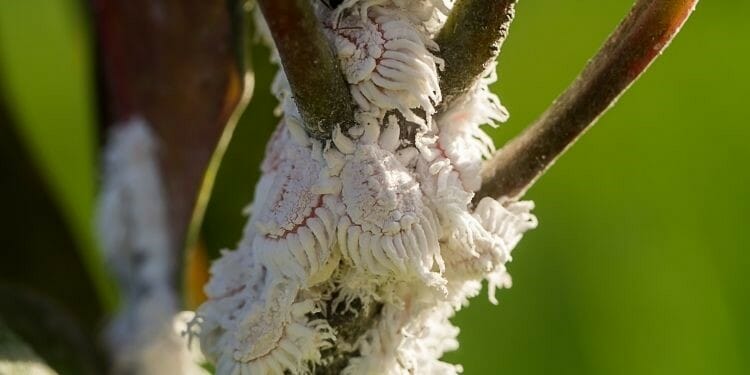String of Dolphins (Senecio peregrinus) is an endearing trailing succulent ideal for hanging baskets. If you look at it closely, the leaves resemble pods of leaping dolphins. Hence its name.
This variety of succulent was created by cross-pollinating String of Pearls (Senecio rowleyanus) and Hot Dog Cactus (Senecio articulatus).
Dolphin succulents are fairly easy to care for but do have some specific requirements. Let’s look at these in more detail.
Our 10 Essential Tips For Your Dolphin Succulents
1. Free-Draining Potting Mix
As you know, succulents don’t like having wet feet and Dolphin succulents are no different. They need a well-draining, open mix to thrive.
You can purchase a specific succulent mix from your local garden center or make your own. The best recipe for a good succulent mix is:
- 2 parts good quality potting mix
- 2 parts coarse builder’s sand
- 1 part Perlite or pumice
This type of mix gives exceptional drainage and allows air pockets for the growing roots.
2. Best Containers
The String of Dolphins doesn’t need a lot of space and does really well as a container plant. It’s ideal for hanging pots or baskets so that the stems can trail down.
Also, the plant doesn’t mind being crowded so you should choose a container just a little larger than the plant itself.
3. Light Requirements
This is one succulent that is not a sun-worshipper. It prefers receiving filtered sunlight and tolerates part-shade really well. In fact, it can easily get sunburned if exposed to sunlight on hot days.
If you’re growing your String of Dolphins outside, place it in a shady spot that receives some filtered sunlight. If growing inside, it’s best to place your plant in a south-facing window. This ensures that the plant will receive morning sunlight and avoids the hot afternoon sun.
MUST SEE: Why are succulents so popular!? Find out here.
4. Temperature Requirements
Although not totally cold-tolerant, Dolphin succulents do prefer cool air. They can tolerate temperatures as low as 40 degrees Fahrenheit in the winter. In fact, this is one succulent that is actually dormant during the colder months. Bear in mind though, that frost will kill this plant if it’s exposed to it.
The ideal growing temperature for these delightful succulents is around 72 degrees Fahrenheit. This means that they make excellent houseplants and prefer to be inside over winter.
Growing your Dolphin succulents in pots is perfect. This means you can bring them inside during winter and the hotter summer days and give them a spell outside when the temperatures are milder.
5. Watering
Like all succulents, String of Dolphins doesn’t like to sit in water. It’s necessary for its roots to dry out in between watering. Due to its soft, fleshy leaves, it has the ability to store plenty of moisture to help the plant survive during dry periods.
The watering frequency for these plants will differ depending on the seasons.
- In spring, summer and early fall, the plant is actively growing. Therefore, you want to water it around once a week. This is because it requires more water when it’s producing more growth.
- In winter the plant will be dormant and not actively growing. Therefore, it only needs to be watered around once a month.
The perfect way to water your Dolphin succulent is to completely soak the soil until the water runs out of the drainage holes in the bottom of the pot. Make sure you let all the water drain out and don’t leave any sitting in the saucer if you’re using one.
Then, check you plant regularly and only water again when the soil is completely dry.
6. How To Tell If Your Dolphin Succulent Is Being Underwatered Or Overwatered
Because String of Dolphins requires a little more water than other succulents, it can run the risk of being underwatered. Inspecting your plant regularly and looking for subtle changes can alert you to the fact that it requires more or less water. Here’s how to tell whether your plant needs more or less water.
- If your plant is underwatered, the leaves will be dull and deflated. They will lose their shiny, plump appearance.
- If your plant is overwatered, the leaves will be yellow and transparent. They may also feel squishy rather than plump.
Once you identify these signs, you’ll easily be able to adjust your watering schedule to ensure that your plant receives just the right amount of water it needs.
7. Should You Fertilize Dolphin Succulents?
You can fertilize your String of Dolphins, but not too much. In fact, over-fertilizing may mean that the plant loses its leaping dolphin look.
You can apply a small amount of fertilizer at the beginning of the plant’s active growth period in early spring. Therefore, only once a year.
8. Flowering
Dolphin succulents flower during spring and summer. Their flowers are small and dainty and resemble a white pompom with lots of yellow stamens. They also have a pleasant cinnamon fragrance.
Remember though, that this plant is a hybrid, so if you collect the seed and try to grow new plants, you’ll most likely not get plants with the leaping dolphin appearance.
9. Propagating New Plants
The only way to propagate new String of Dolphin plants successfully is by using stem cuttings. Follow these steps to create new plants:
- Prepare your propagating tray and mix. You can use the same mix that you use to grow your succulents in.
- Take some stem cuttings from your plant that are around 5 inches long. Make sure the piece of stem is firm and has healthy leaves. Cut just below a leaf node.
- Remove the leaves at the bottom of the stem and leave just a couple at the top.
- Leave your stem cuttings in a warm, dry spot to dry out.
- Once you see callouses on the cut end of your stems, they’re ready for planting.
- You might like to dip your stems in a little rooting hormone to assist root formation. Or, you can use pure, natural honey or even cinnamon powder. This will discourage fungal growth too.
- Make a hole in your propagating tray with a pencil or dibbler and push the cut stems into the soil.
- Water the tray thoroughly and let it drain.
- Keep the tray of cuttings in a warm spot, out of direct sunlight.
- Make sure you water the tray when you see that the top soil is dry. Never let it dry out completely while the plants are in the process of growing roots.
- Once you start to see new growth appearing on the young plants, you can replant them into their own pots.
10. Pests And Diseases
Succulents are generally not prone to many pests or diseases. The only diseases you need to watch out for are fungal infections. However, these generally only appear if you overwater your plant.
The only pests that may infect your Dolphin succulent are spider mites and mealybugs. These can be quite common for plants that are grown indoors. Here’s how to take care of them.
- Mealy Bugs. These will appear as a fuzzy white substance on your plant. They will actually feed on your plant and if left untreated, can eventually kill it. The most effective way to kill mealy bugs is to swab them with 75% rubbing alcohol (isopropyl).
However, if the plant is heavily infected, it might be better to put the rubbing alcohol into a spray bottle and spray the entire plant thoroughly. The alcohol will kill the mealy bugs but not harm your plant because it evaporates quickly.
You need to continue this treatment until all the mealy bugs are dead. Once a week is good. Once the bugs are all dead, you can rinse the plant with water to get rid of all of them.
- Spider Mites. These pests will spin small webs on the underside of the leaves. They feed on the plant by sucking out the juices. These pests also thrive in hot, dry conditions. Common signs of infestation include small dots or patches of white on the leaves.
Your first step in treating spider mites is to get rid of the webs that protect them. As these are found on the underside of the leaves, it’s best to take your plant outside and spray it with a hose.
Once you’ve dislodged the webs, it’s time to kill the mites themselves. This is best done with insecticidal soap. You can buy this from your local garden center or online. Mix up the required quantity and spray your plant, making sure you coat the underside of the leaves as well.
Repeat this process until you can see no more signs of infection.
Frequently Asked Questions:
How much sun does String of Dolphins need?
It’s best to keep your Dolphin succulents out of direct sunlight in the heat of the day. Ideally, 6 hours of morning sunlight is sufficient for these plants to thrive.
Can you root String of Dolphins in water?
Yes, using stem cuttings. Just prepare your cuttings as above and then place in water and wait for roots to form.
How fast do String of Dolphins grow?
Dolphin succulents can grow over 20 inches in just one year.
Final Thoughts
We hope you’ve enjoyed our comprehensive guide for growing Dolphin succulents. I’m sure these whimsical plants would make a great addition to your succulent collection.
Remember, String of Dolphins likes a little more water in the growing season but only needs to be watered once a month during winter when it’s dormant. It can also tolerate slightly cooler temperatures but doesn’t like frost or direct sunlight.
It’s the perfect plant to grow in a hanging pot where the stems of leaping dolphins can cascade down as it grows.
Have you grown Dolphin succulents? Please feel free to share your stories with us in the comments below.







